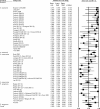Systematic review and meta-analysis of in vitro synergy of polymyxins and carbapenems
- PMID: 23917322
- PMCID: PMC3811454
- DOI: 10.1128/AAC.01230-13
Systematic review and meta-analysis of in vitro synergy of polymyxins and carbapenems
Abstract
Our objective was to examine the evidence of in vitro synergy of polymyxin-carbapenem combination therapy against Gram-negative bacteria (GNB). A systematic review and meta-analysis were performed. All studies examining in vitro interactions of antibiotic combinations consisting of any carbapenem with colistin or polymyxin B against any GNB were used. A broad search was conducted with no language, date, or publication status restrictions. Synergy rates, defined as a fractional inhibitory concentration index of ≤0.5 or a >2-log reduction in CFU, were pooled separately for time-kill, checkerboard, and Etest methods in a mixed-effect meta-analysis of rates. We examined whether the synergy rate depended on the testing method, type of antibiotic, bacteria, and resistance to carbapenems. Pooled rates with 95% confidence intervals (CI) are shown. Thirty-nine published studies and 15 conference proceeding were included, reporting on 246 different tests on 1,054 bacterial isolates. In time-kill studies, combination therapy showed synergy rates of 77% (95% CI, 64 to 87%) for Acinetobacter baumannii, 44% (95% CI, 30 to 59%) for Klebsiella pneumoniae, and 50% (95% CI, 30 to 69%) for Pseudomonas aeruginosa, with low antagonism rates for all. Doripenem showed high synergy rates for all three bacteria. For A. baumannii, meropenem was more synergistic than imipenem, whereas for P. aeruginosa the opposite was true. Checkerboard and Etest studies generally reported lower synergy rates than time-kill studies. The use of combination therapy led to less resistance development in vitro. The combination of a carbapenem with a polymyxin against GNB, especially A. baumannii, is supported in vitro by high synergy rates, with low antagonism and less resistance development. These findings should be examined in clinical studies.
Figures


References
-
- Yahav D, Farbman L, Leibovici L, Paul M. 2012. Colistin: new lessons on an old antibiotic. Clin. Microbiol. Infect. 18:18–29 - PubMed
-
- Falagas ME, Kasiakou SK, Saravolatz LD. 2005. Colistin: the revival of polymyxins for the management of multidrug-resistant gram-negative bacterial infections. Clin. Infect. Dis. 40:1333–1341 - PubMed
-
- Paul M, Bishara J, Levcovich A, Chowers M, Goldberg E, Singer P, Lev S, Leon P, Raskin M, Yahav D. 2010. Effectiveness and safety of colistin: prospective comparative cohort study. J. Antimicrob. Chemother. 65:1019–1027 - PubMed
-
- Couet W, Gregoire N, Marchand S, Mimoz O. 2012. Colistin pharmacokinetics: the fog is lifting. Clin. Microbiol. Infect. 18:30–39 - PubMed
Publication types
MeSH terms
Substances
LinkOut - more resources
Full Text Sources
Other Literature Sources
Medical
Molecular Biology Databases

